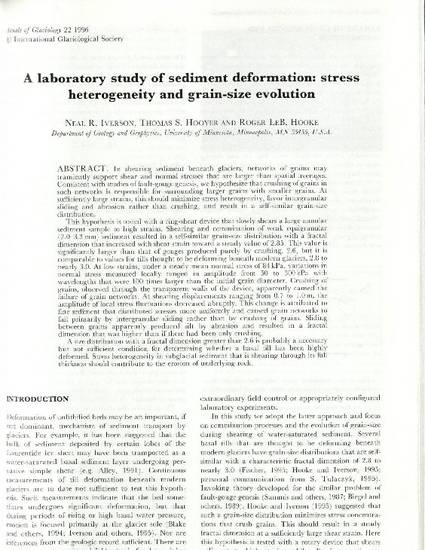
Article
A Laboratory Study of Sediment Deformation: Stress Heterogeneity and Grain-Size Evolution
Journal of Glaciology
(1996)
Abstract
In shearing sediment beneath glaciers, networks of grains may transiently support shear and normal stresses that are larger than spatial averages. Consistent with studies of fault-gouge genesis, we hypothesize that crushing of grains in such networks is responsible for surrounding larger grains with smaller grains. At sufficiently large strains, this should minimize stress heterogeneity, favor intergranular sliding and abrasion rather than crushing, and result in a self-similar grain-size distribution.
This hypothesis is tested with a ring-shear device that slowly shears a large annular sediment sample to high strains. Shearing and comminution of weak equigranular (2.0‐3.3 mm) sediment resulted in a self-similar grain-size distribution with a fractal dimension that increased with shear strain toward a steady value of 2.85. This value is significantly larger than that of gouges produced purely by crushing, 2.6, but it is comparable to values for tilts thought to be deforming beneath modern glaciers, 2.8 to nearly 3.0. At low strains, under a steady mean normal stress of 84 kPa, variations in normal stress measured locally ranged in amplitude from 50 to 300 kPa with wavelengths that were 100 times larger than the initial grain diameter. Crushing of grains, observed through the transparent walls of the device, apparently caused the failure of grain networks. At shearing displacements ranging from 0.7 to 1.0 m, the amplitude of local stress fluctuations decreased abruptly. This change is attributed to fine sediment that distributed stresses more uniformly and caused grain networks to fail primarily by intergranular sliding rather than by crushing of grains. Sliding between grains apparently produced silt by abrasion and resulted in a fractal dimension that was higher than if there had been only crushing.
A size distribution with a fractal dimension greater than 2.6 is probably a necessary but not sufficient condition for determining whether a basal till has been highly deformed. Stress heterogeneity in subglacial sediment that is shearing through its full thickness should contribute to the erosion of underlying rock.
Disciplines
Publication Date
1996
DOI
10.3198/1996AoG22-1-167-175
Publisher Statement
Copyright International Glaciological Society 1996. Posted with permission.
Citation Information
Neal R. Iverson, Thomas S. Hooyer and Roger LeB. Hooke. "A Laboratory Study of Sediment Deformation: Stress Heterogeneity and Grain-Size Evolution" Journal of Glaciology Vol. 22 Iss. 1 (1996) p. 167 - 175 Available at: http://works.bepress.com/neal-iverson/19/
Creative Commons license

This work is licensed under a Creative Commons CC_BY International License.
